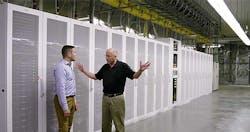Microsoft has bought 65 acres of land in northern San Jose, and plans to build a data center campus on the property, the company confirmed Friday. Microsoft’s plans mark a departure from several prevailing trends in the Silicon Valley data center market, where most of the action has focused in Santa Clara, and hyperscale players have historically leased space from third-party providers, rather than building their own facilities.
The deal demonstrates that cloud platforms continue to covet data center capacity in the largest U.S. markets, even as they build huge cloud campuses in rural and suburban locations like Oregon and Iowa. It’s not immediately clear whether Microsoft’s decision to build in Silicon Valley represents an evolution in its data center strategy, or (perhaps more likely) is simply an opportunistic move in a supply-constrained market.
Local media reported Friday that Microsoft has paid $73.2 million to buy land near the interchange of Routes 237 and 880 in San Jose. The 65-acre property, known as the 237 Industrial Center, is currently farmland with several small structures. Microsoft brought the land from the Cilker family, which has run orchards and real estate in Silicon Valley.
The site is zoned light industrial, and San Jose planners include an option to develop a 436,800 square foot, 50 megawatt data center and PG&E energy substation at the site, as well as 738,000 square feet of light industrial space.
“We continuously explore opportunities to meet the needs of a future based on cloud computing and internet services, so we’re thrilled to find a great one in the heart of Silicon Valley,” said Christian Belady, general manager of Microsoft Cloud Infrastructure and Operations, told the San Jose Mercury News.
Supply Constraints in Santa Clara
Microsoft’s decision reflects how the lack of land and data center supply in Santa Clara is opening development in adjacent cities. Santa Clara has long been the Data Center Capital of Silicon Valley due to competitive power pricing from the municipal utility, Silicon Valley Power, whose rates are significantly lower than the cost of power from PG&E in surrounding towns. That’s why there’s 34 data centers located in a three-and-a-half square mile area within Santa Clara.
But development sites have grown scarce in Santa Clara, prompting data center developers to seek sites with existing buildings that can be demolished to make way for data center campuses. Vantage Data Centers, CoreSite and Digital Realty have all expanded by acquiring sites with existing structures and knocking them down to make way for server space. Meanwhile, both CoreSite and Vantage are building four-story data centers to get the most capacity possible out of their existing real estate.
This appears to have created an opportunity for San Jose, which also has a strong data center heritage and is home to major campuses for Equinix and Infomart Data Centers, as well as one of the Valley’s key connectivity hubs at CoreSite’s Market Post Tower.
Appetite for Cloud Campuses
The 237 Industrial Center, located between Zanker Road and Coyote Creek in San Jose, offers the kind of campus environment preferred by hyperscale companies, who typically build large, multi-building cloud campuses. These data center hubs offer economies of scale, enabling companies to rapidly add server capacity and electric power as more workloads shift from in-house IT rooms into these massive server farms.
In recent years, Microsoft has typically leased space in primary markets like Silicon Valley, Northern Virginia and Chicago. In 2016 the company reportedly leased 125 megawatts of third-party data center space. Microsoft has reportedly signed large wholesale deals with Vantage Data Centers in 2015 and DuPont Fabros (now part of Digital Realty) in 2016.
San Jose officials say Microsoft has not yet decided on the details of its development plan. Microsoft could build itself, but could also work with a data center developer on a built-to-suit project, similar to its reported new deployment at CloudHQ in Manassas, Virginia. Since the project is likely still several years off, Microsoft could also remain a player in the market for wholesale space in Silicon Valley.
Data Center Frontier will continue tracking the real estate and leasing trends in Silicon Valley and Northern Virginia. Subscribe to our email newsletter to stay current on the latest news and trends.
Microsoft Continues to Innovate
Microsoft continues to innovate in its data center operations, seeking improved efficiencies and new ways to operate sustainably. The company is competing aggressively in the cloud computing market, where its chief rivals include Amazon Web Services, Google and Oracle.
Last year, Microsoft introduced its Generation 5 facility, the latest of its ongoing refinements of its data center design, with regular updates to include the latest innovations and best practices. The new facility has a cement slab rather than a raised floor, and servers are housed in rows of racks that are connected to a hot-aisle containment system. A fan wall on one side of the facility manages airflow into the data hall, which functions as a room-level cold aisle – although “cold” is a relative term, as Microsoft can operate its data centers with server inlet temperatures above 80 degrees.
Microsoft has also been researching underwater data centers, powering cloud capacity with natural gas and fuel cells, and the use of energy-efficient ARM servers.
About the Author



